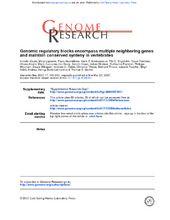Genomic regulatory blocks encompass multiple neighboring genes and maintain conserved synteny in vertebrates
Kikuta, Hiroshi; Laplante, Mary; Navrátilová, Pavla; Komisarczuk, Anna Zofia; Engström, Pär G.; Fredman, David; Akalin, Altuna; Caccamo, Mario; Sealy, Ian; Howe, Kerstin; Ghislain, Julien; Pezeron, Guillaume; Mourrain, Philippe; Ellingsen, Staale; Oates, Andrew C.; Thisse, Christine; Thisse, Bernard; Foucher, Isabelle; Adolf, Birgit; Geling, Andrea; Lenhard, Boris; Becker, Thomas S.
Peer reviewed, Journal article
Permanent lenke
https://hdl.handle.net/1956/2742Utgivelsesdato
2007-03-06Metadata
Vis full innførselSamlinger
Originalversjon
https://doi.org/10.1101/gr.6086307Sammendrag
We report evidence for a mechanism for the maintenance of long-range conserved synteny across vertebrate genomes. We found the largest mammal-teleost conserved chromosomal segments to be spanned by highly conserved noncoding elements (HCNEs), their developmental regulatory target genes, and phylogenetically and functionally unrelated "bystander" genes. Bystander genes are not specifically under the control of the regulatory elements that drive the target genes and are expressed in patterns that are different from those of the target genes. Reporter insertions distal to zebrafish developmental regulatory genes pax6.1/2, rx3, id1, and fgf8 and miRNA genes mirn9-1 and mirn9-5 recapitulate the expression patterns of these genes even if located inside or beyond bystander genes, suggesting that the regulatory domain of a developmental regulatory gene can extend into and beyond adjacent transcriptional units. We termed these chromosomal segments genomic regulatory blocks (GRBs). After whole genome duplication in teleosts, GRBs, including HCNEs and target genes, were often maintained in both copies, while bystander genes were typically lost from one GRB, strongly suggesting that evolutionary pressure acts to keep the single-copy GRBs of higher vertebrates intact. We show that loss of bystander genes and other mutational events suffered by duplicated GRBs in teleost genomes permits target gene identification and HCNE/target gene assignment. These findings explain the absence of evolutionary breakpoints from large vertebrate chromosomal segments and will aid in the recognition of position effect mutations within human GRBs.
